
The Breed History
A Ruddy Abyssinian and Seal Point Siamese breeding was carried
out to try to produce a new type of pointed Siamese. The outcome
in the F1 resulted in the desired pattern, but after backcross to
another Siamese cat, they produced a second, unusually coated
offspring in that second generation-a light spotted cat. This was an
unexpected outcome. This cat looked a lot like an extinct Egyptian
type cat. Other breeding programs were begun to replicate this
combination of coat genes, so the breed now has a broad genetic
base with the Dalai line being prominent.
Early breed development also involved American Shorthair cats.
The breed name is derived from the Ocelot, a wild spotted feline
in combination with the word cat. The CFA first recognized these
cats in 1966. The registries CFA and TICA accepted the breed for
championship status in 1987-88. In 1986, the CFA closed the
registry to American Shorthair and Siamese outcross breeding. This
continues to be a rare breed. Outcrosses to Abyssinian were no
longer allowed as of 2005.
Physical Characteristics
Weight: 6-14 lb (2.5-6.5 kg), females are smaller than males
Coat: The coat is very short, dense, flat lying and smooth with a
pronounced gloss. The bull's eye agouti dark spot markings on a
lighter background coat may not be distinct in young kittens, but
will sharpen as they mature. Distinct spots are very important.
Classic tabby markings are pet quality. Tip of tail hairs color reflects
base coat color; other hairs are all agouti. Twelve colors are shown
in five divisions. A distinct "M" mark is on the forehead and mascara
markings are present.
Eyes: Colors are accepted in gold, green and copper spectrum but
not blue.
Points of Conformation: The Ocicat head is a modified wedge
shape with broad nose and muzzle. The Ocicat is a long bodied cat.
Ears are large and angle outward. The tail is slightly tapering and
long. Feet are compact and oval.
Grooming: Minimal grooming is needed for the Ocicat; a soft
brush, chamois or hands will keep the coat well maintained.
Recognized Behavior Issues and Traits
Reported breed characteristics include: Affectionate, curious, active,
playful; some can be lap cats. Need human companionship, devoted
but not clinging, easy to train; can leash train, fetch, and are
adaptable in new environments. They are good with children and
other pets, and also with strangers. Sociable; they behave a bit like a
dog. Ocicats like to talk but are less vocal than Siamese.
Normal Breed Variations
Known for easy birth and good mothering
Ocicat Kitten Information Project: An Internet based breeder
survey was carried out to establish normal baselines for
reproduction.
40 reporting breeders, 136 litters, 581 kittens,
Nov 2003-Oct 2004;
Average litter size 4.3
Stillbirth rate 4 %
C-sections 4%
Average birth weight: Male 101 g female 95 g
Drug Sensitivities
None reported in the literature
Inherited Diseases
Progressive Retinal Atrophy (rdAc): Auto recessive disease
causing blindness. See under Abyssinian breed. A genetic test is
available.
Disease Predispositions
None reported in the literature
Genetic Tests
Direct genetic test for rdAc-PRA is available from UC-Davis VGL.
Miscellaneous
- Breed name synonyms: Oci, Spotted Cat, Ocelot
- Registries: FIFe, TICA, CFA, ACFA, ACF, GCCF, WCF, CCA, NZCF
- Breed resources: CFA Ocicat Breed Council:
http://www.ocicatinfo.org
Ocicats of North America (CFA):
http://www.catoninetail.com/ona/
Ocicats International: http://www.ocicatsinternational.com/
Photo Gallery of Breed - Ocicat - Dog Breed
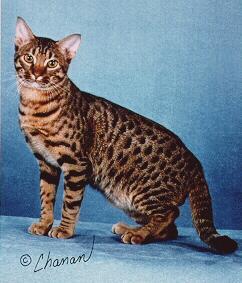
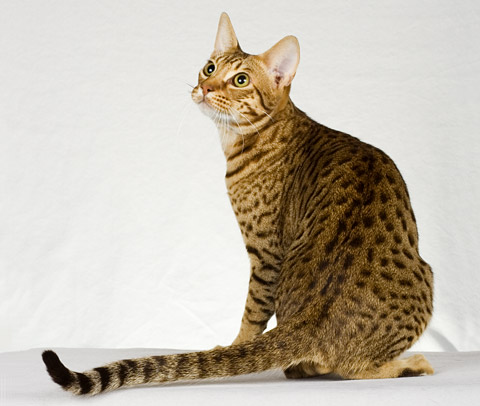
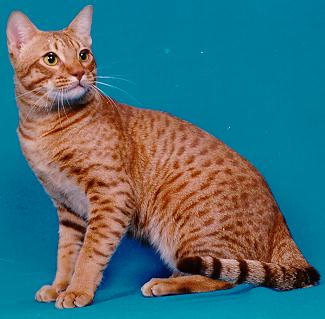

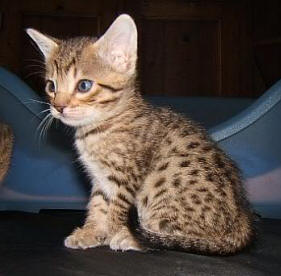
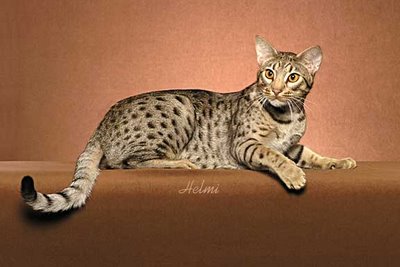


 Animalia Life
Animalia Life